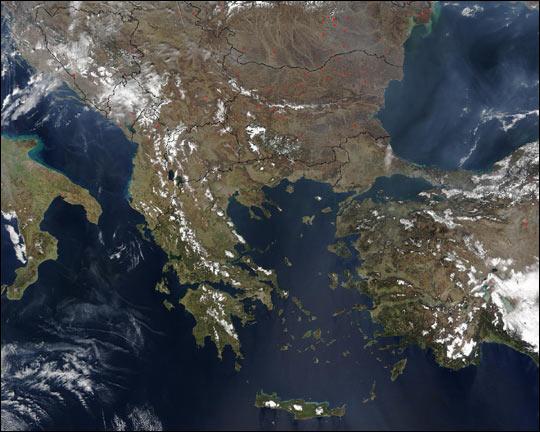

Mid-latitude continental, hot summers, mild winters; semiarid to polar in the Pamir Mountains
The Pamir and Alay Mountains dominate Tajikistan's landscape The western Fergana Valley is in north, and the Kofarnihon and Vakhsh Valleys are in the southwest
The country's lowest point is at Syr Darya 300 m, and it's highest point is at Qullai Ismoili Somoni 7,495 m
The region covering today's Tajikistan was part the of Persian empires for much of its history This region has been an important place for flourishing Persian culture and language
In recent history, Tajikistan has experienced three changes in government and a five-year civil war since it gained independence from the USSR in 1991 A peace agreement among rival factions was signed in 1997 and implemented in 2000 The central government's less than total control over some areas of the country has forced it to compromise and forge alliances among factions Attention by the international community in the wake of the war in Afghanistan has brought increased economic development assistance, which could create jobs and increase stability in the long term Tajikistan is in the early stages of seeking World Trade Organization membership and has joined NATO's Partnership for Peace
Tajik, closely related to Persian and mutually intelligible with it, is the primary and historical language of Tajikistan Due to Soviet promotion of Russian, many older Tajiks speak fluent Russian, while among the younger generations, the most fluent in Russian are found in the cities and north Some people use Russian as their language Russian is widely used in government, which means that some government officials, such as policemen may speak it English, however is virtually non-existant
The Grand Palace in Bangkok is one of the must-sees
Somoni TJS, Tajik: cомонӣ is the national currency As of December, 2009, US$ 1 roughly equals to 438 somoni, while € 1 equals to 660 somoni
Food in Tajikistan is a cross between that of Central Asia and that of Afghaistan & Pakistan along with a bit of Russian influence If you like Russian food, you will probably have a good culinary experience If you find Russian food bland, you may have a rough time here
Take care with street food and do NOT eat unwashed vegetables and fruits It's best to soak them in distilled water and cook thoroughly
Now situation is different National cuisine is becoming more popular in Tajikistan, such as Shurpo, Oshi Palov, Mantu, Sambusa and etc
Sleeping options in Tajikistan include the following:
Hotels In Dushanbe, there are a small number of large hotels The Hyatt Regency just built recently and opens doors in March 2009 Another one of big hotels is "Tajikistan" recently renovated, located in the central city Most are ex-Soviet era and tend to be over priced and in poor condition There are a couple of newly built hotels offering western standards of accommodation for around from $US70 to $US220 per room
MSDSP Guesthouses,
The Aga Khan's Mountain Societies Development Support Programme has a network of guesthouses in places like Kalaikhum and Khorog, offering a good standard of accommodation Full board is around $US40 per person
Formal Homestays
The French NGO ACTED is establishing a network of Homestays in the Pamir region, around Murgab, For around $US10 per person per night you get a comfortable bed in a family home The facilities are basic, ie no running water and an outside toilet, but guests can expect comfortable clean rooms, good local food, and a very warm welcome
Independent Guesthouses
In Dushanbe, Khorog, and Murghab there are a small but growing number of independent guesthouses These are similar in standard and price to the ACTED homestays
Online Accommodation couchsurfing
Many cities of Tajikistan offer free accommodation in homestays through the couchsurfingcom
At embassies, NGOs 3, some hotels A few hundred expatriates live in Dushanbe Several ads each week in the electronic newsletter WhatsOnInDushanbe For investors, cf 4 and similar publications
Habitat for Humanity-Tajikistan, 5, constructs homes for needy, low-income families in addition to completing many unfinished Soviet-era homes and apartment blocks, provides seismic retrofits, works to provide sanitary water, and more Once or twice a year, volunteer trips through HFH "Global Village" program, 6 are offered, entailing 2 weeks of building houses combined with a few days of sightseeing